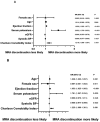Motives, frequency, predictors and outcomes of MRA discontinuation in a real-world heart failure population
- PMID: 36919930
- PMCID: PMC9438023
- DOI: 10.1136/openhrt-2022-002022
Motives, frequency, predictors and outcomes of MRA discontinuation in a real-world heart failure population
Abstract
Introduction: Mineralocorticoid receptor antagonists (MRAs) reduce mortality and morbidity in patients with heart failure and reduced ejection fraction (HFrEF), but are largely underused. We evaluated the frequency, motives, predictors and outcomes of MRA discontinuation in a real-world heart failure population.
Methods and results: This was a single-centre, retrospective cohort study where medical record-based data were collected on patients with HFrEF between 2010 and 2018. In the final analysis, 572 patients were included that comprised the continued MRA group (n=275) and the discontinued MRA group (n=297). Patients that discontinued MRA were older, had a higher comorbidity index and a lower index estimated glomerular filtration rate (eGFR). Predictors of MRA discontinuations were increased S-potassium, lower eGFR, lower systolic blood pressure, higher frequency of comorbidities and a higher left ventricular ejection fraction. The most common reason for MRA discontinuation was renal dysfunction (n=97, 33%) with 59% of these having an eGFR <30 mL/min/1.73m2, and elevated S-potassium (n=71, 24%) with 32% of these having an S-potassium >5.5 mmol/L. Discontinuation of MRA increased the adjusted risk of all-cause mortality (HR 1.48; 95% CI 1.07 to 2.05; p=0.019).
Conclusions: Half of all patients with HFrEF initiated on MRA discontinued the treatment. A substantial number of patients discontinued MRA without meeting the guideline-recommended levels of eGFR and S-potassium where mild to moderate hyperkalaemia seems to be the most decisive predictor. Further, MRA discontinuation was associated with increased adjusted risk of all-cause mortality.
Keywords: drug monitoring; heart failure; pharmacology, clinical.
© Author(s) (or their employer(s)) 2022. Re-use permitted under CC BY-NC. No commercial re-use. See rights and permissions. Published by BMJ.
Conflict of interest statement
Competing interests: None declared.
Figures




References
MeSH terms
Substances
LinkOut - more resources
Full Text Sources
Medical
Research Materials
Miscellaneous
